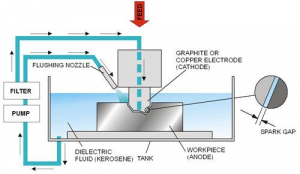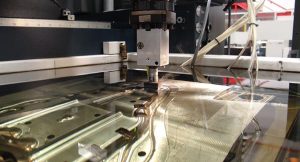What is EDM?
EDM is an acronym. It stands for electric discharge machining. In the dielectric fluid for insulation, the distance between the conductive tooling electrode and the workpiece is about several tens of mm. Applying a periodically rapid voltage pulse to generate intermittent high-pressure spark discharge and heat. Local high temperature to melt or vaporize the surface of the workpiece, thereby achieving metal erosion. Since the material is removed by thermal energy rather than mechanics, the strength and hardness of the material won’t be affected.

Advantage
- It can make odd-shaped surfaces that cannot be produced by traditional cutting machines.
- Hard materials can also be processed with good tolerances.
- The cutting force of conventional processing machines may damage small workpieces, but it will not happen with electrical discharge machining.
- Sharp corner processing inside containers and pipes
- Small deep hole machining to dia 0.015″
Disadvantages
- Cannot process non-conductors (there are techniques to process ceramic materials).
- Processing speed is slow.
- High processing costs.
Applications of EDM
EDM is widely used in mold manufacturing and machining industries. It can be used to machine ultra-hard materials (with conductibility) such as titanium alloys, tool steels, carbon steels, and hard alloys, etc. and complex-shaped workpieces that are difficult to machine with conventional cutting methods. It also can be used to make precise and tiny parts.
You can find the photo display of the CNC machining parts made by us HERE!

